MeatPack Case Study: Leadership, Cultural, and Performance Change
VerifiedAdded on 2023/06/04
|15
|3415
|465
Case Study
AI Summary
This case study analyzes the leadership, cultural, and performance changes at MeatPack, a family-owned food-processing business. The study focuses on Derek Bison, the CEO, and his efforts to develop leadership competencies within the senior strategy team. The analysis explores Bison's hands-on approach and its impact on employee engagement, communication, and organizational performance. It examines the advantages and disadvantages of both hands-on and hands-off leadership styles, with a recommendation for Bison to adopt a hands-on approach. The case also discusses the implementation of a Human Synergistic program and enterprise resource planning, highlighting the challenges and opportunities associated with these initiatives. The study provides recommendations for improving senior leadership effectiveness, including employee engagement, fair opportunities, regular meetings, performance appraisals, and united planning. The document also provides solutions for the questions in the case study.
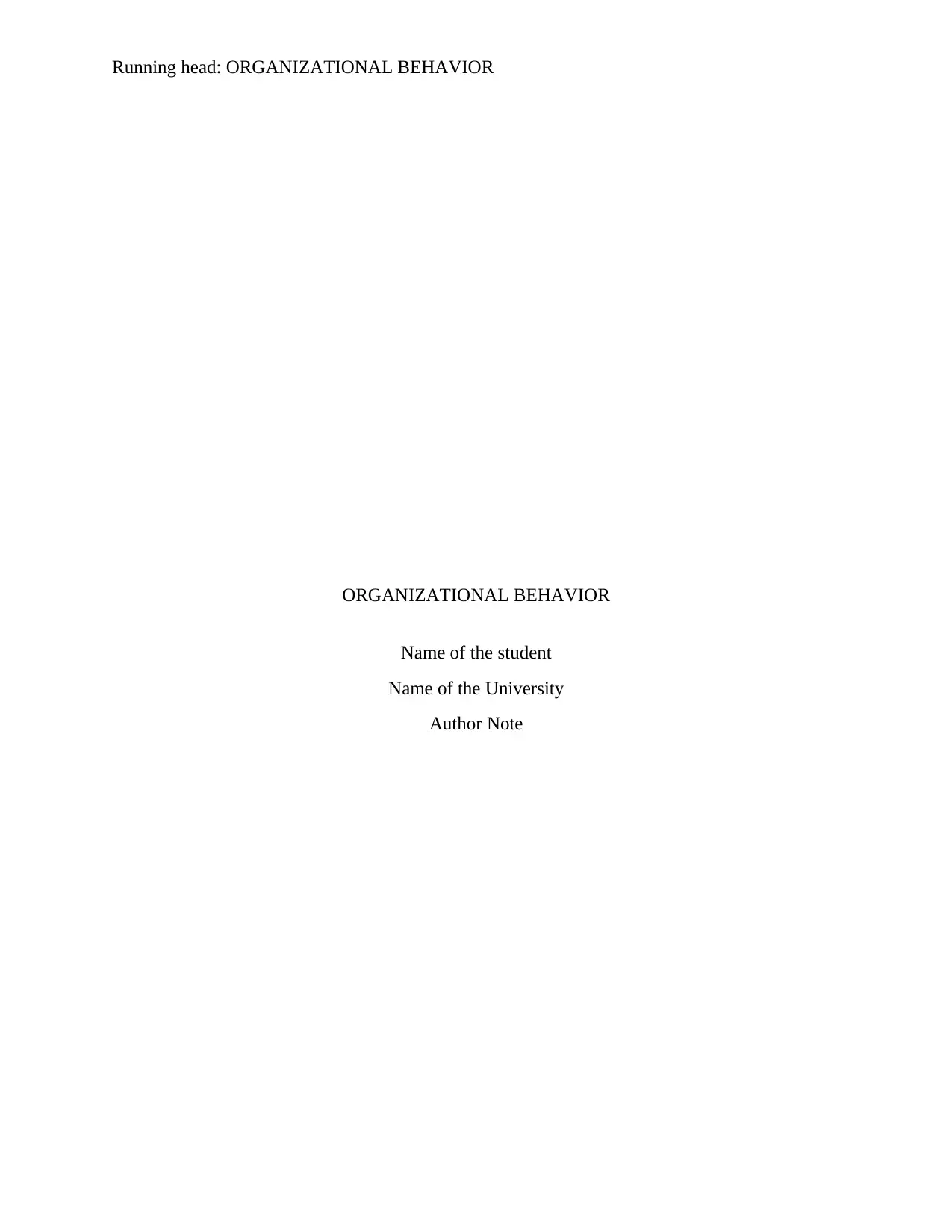
Running head: ORGANIZATIONAL BEHAVIOR
ORGANIZATIONAL BEHAVIOR
Name of the student
Name of the University
Author Note
ORGANIZATIONAL BEHAVIOR
Name of the student
Name of the University
Author Note
Paraphrase This Document
Need a fresh take? Get an instant paraphrase of this document with our AI Paraphraser
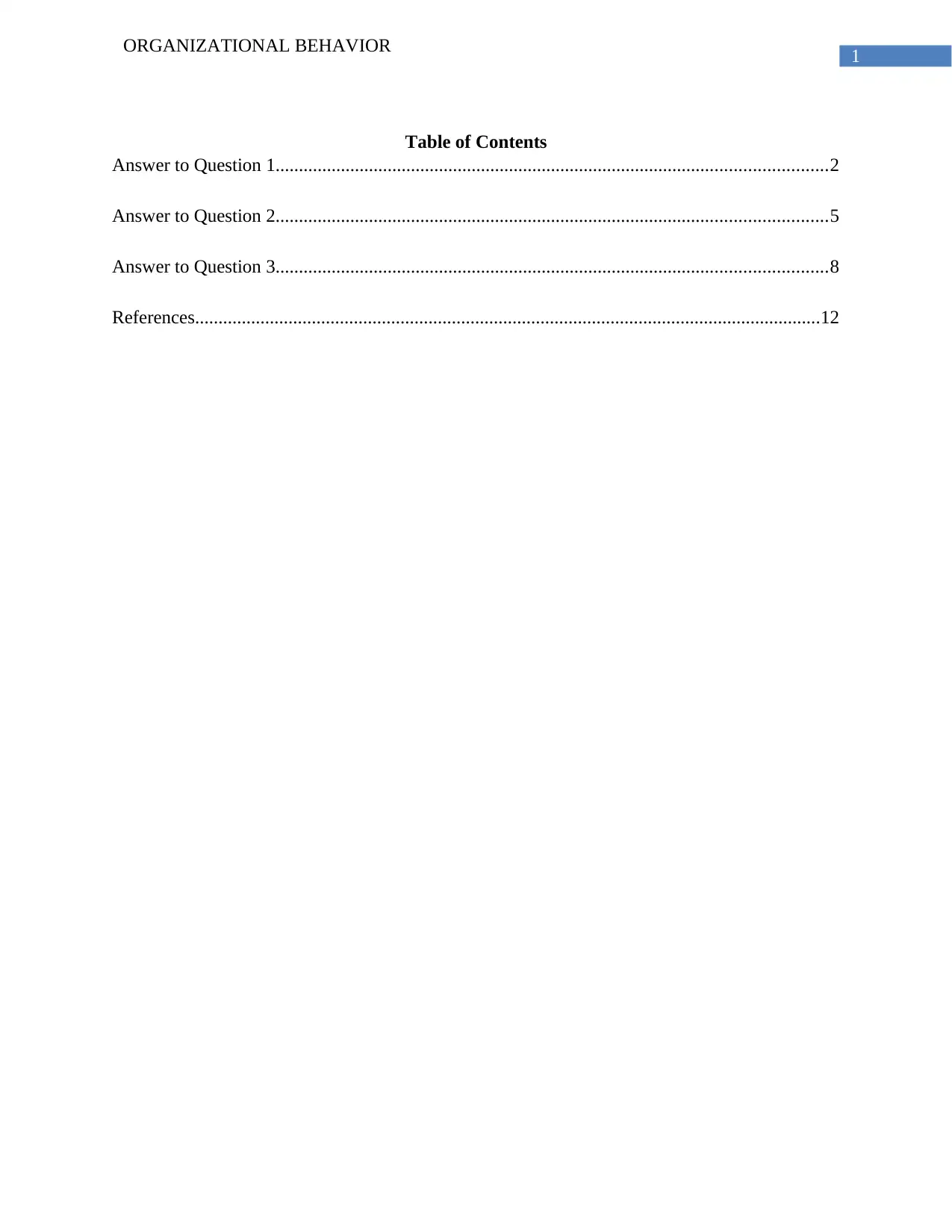
1
ORGANIZATIONAL BEHAVIOR
Table of Contents
Answer to Question 1......................................................................................................................2
Answer to Question 2......................................................................................................................5
Answer to Question 3......................................................................................................................8
References......................................................................................................................................12
ORGANIZATIONAL BEHAVIOR
Table of Contents
Answer to Question 1......................................................................................................................2
Answer to Question 2......................................................................................................................5
Answer to Question 3......................................................................................................................8
References......................................................................................................................................12
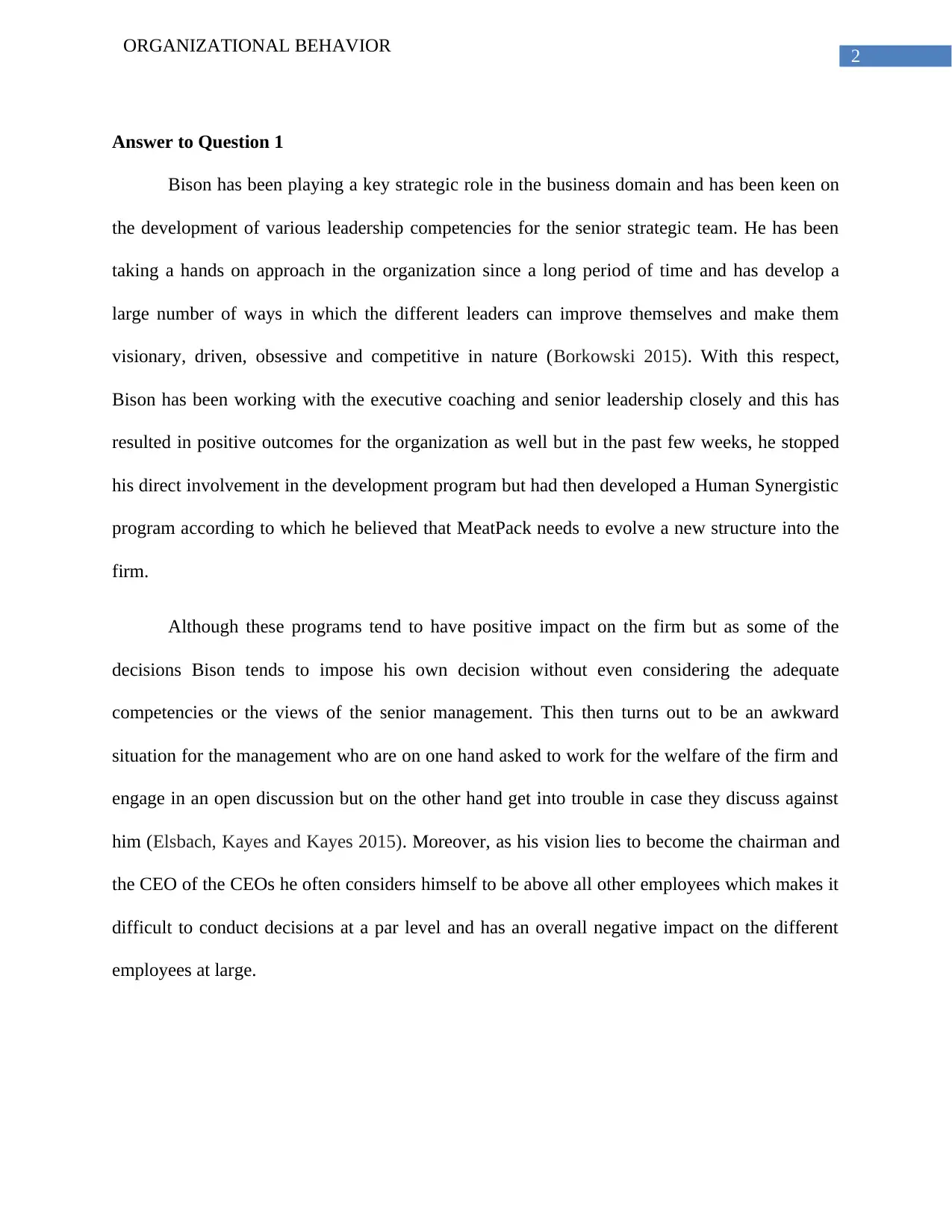
2
ORGANIZATIONAL BEHAVIOR
Answer to Question 1
Bison has been playing a key strategic role in the business domain and has been keen on
the development of various leadership competencies for the senior strategic team. He has been
taking a hands on approach in the organization since a long period of time and has develop a
large number of ways in which the different leaders can improve themselves and make them
visionary, driven, obsessive and competitive in nature (Borkowski 2015). With this respect,
Bison has been working with the executive coaching and senior leadership closely and this has
resulted in positive outcomes for the organization as well but in the past few weeks, he stopped
his direct involvement in the development program but had then developed a Human Synergistic
program according to which he believed that MeatPack needs to evolve a new structure into the
firm.
Although these programs tend to have positive impact on the firm but as some of the
decisions Bison tends to impose his own decision without even considering the adequate
competencies or the views of the senior management. This then turns out to be an awkward
situation for the management who are on one hand asked to work for the welfare of the firm and
engage in an open discussion but on the other hand get into trouble in case they discuss against
him (Elsbach, Kayes and Kayes 2015). Moreover, as his vision lies to become the chairman and
the CEO of the CEOs he often considers himself to be above all other employees which makes it
difficult to conduct decisions at a par level and has an overall negative impact on the different
employees at large.
ORGANIZATIONAL BEHAVIOR
Answer to Question 1
Bison has been playing a key strategic role in the business domain and has been keen on
the development of various leadership competencies for the senior strategic team. He has been
taking a hands on approach in the organization since a long period of time and has develop a
large number of ways in which the different leaders can improve themselves and make them
visionary, driven, obsessive and competitive in nature (Borkowski 2015). With this respect,
Bison has been working with the executive coaching and senior leadership closely and this has
resulted in positive outcomes for the organization as well but in the past few weeks, he stopped
his direct involvement in the development program but had then developed a Human Synergistic
program according to which he believed that MeatPack needs to evolve a new structure into the
firm.
Although these programs tend to have positive impact on the firm but as some of the
decisions Bison tends to impose his own decision without even considering the adequate
competencies or the views of the senior management. This then turns out to be an awkward
situation for the management who are on one hand asked to work for the welfare of the firm and
engage in an open discussion but on the other hand get into trouble in case they discuss against
him (Elsbach, Kayes and Kayes 2015). Moreover, as his vision lies to become the chairman and
the CEO of the CEOs he often considers himself to be above all other employees which makes it
difficult to conduct decisions at a par level and has an overall negative impact on the different
employees at large.
⊘ This is a preview!⊘
Do you want full access?
Subscribe today to unlock all pages.

Trusted by 1+ million students worldwide
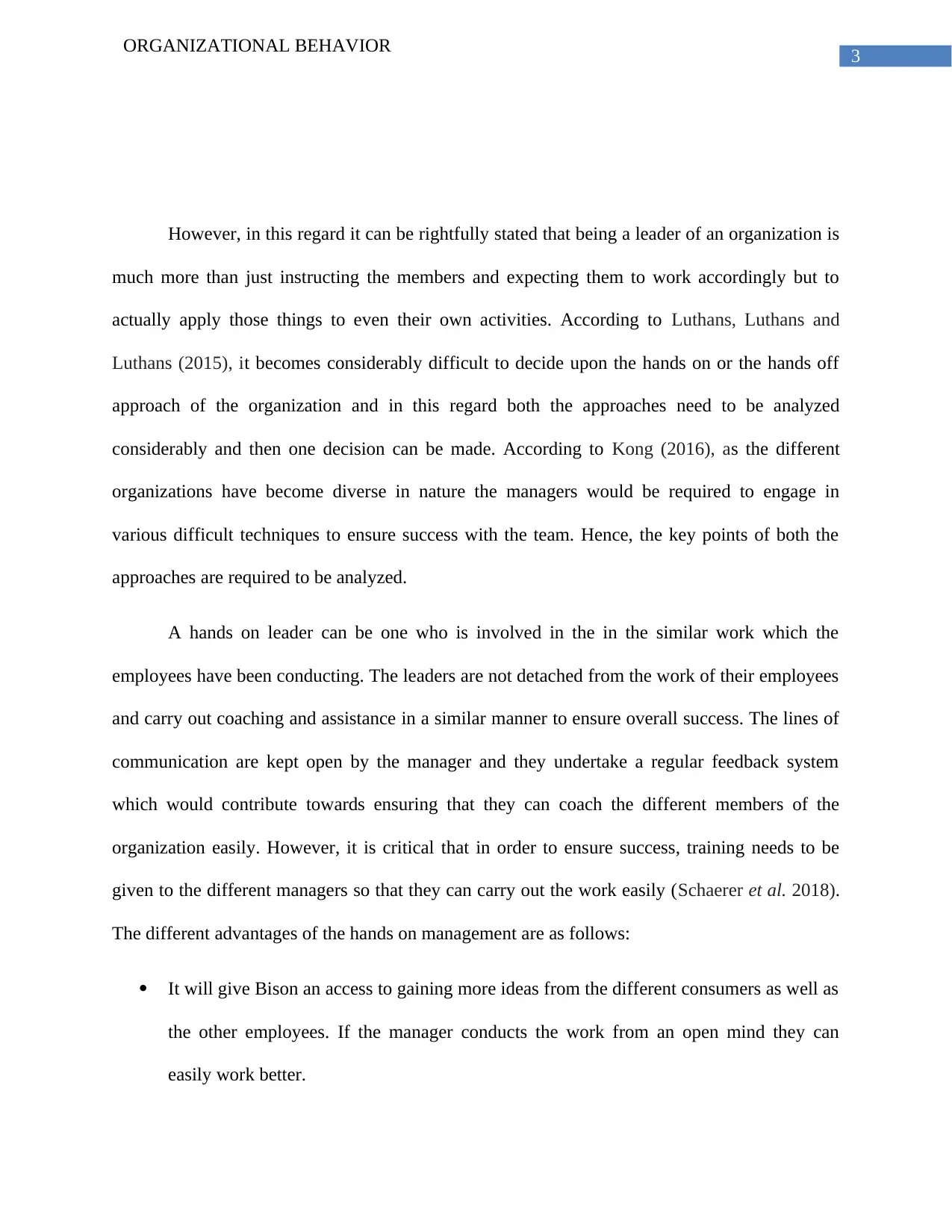
3
ORGANIZATIONAL BEHAVIOR
However, in this regard it can be rightfully stated that being a leader of an organization is
much more than just instructing the members and expecting them to work accordingly but to
actually apply those things to even their own activities. According to Luthans, Luthans and
Luthans (2015), it becomes considerably difficult to decide upon the hands on or the hands off
approach of the organization and in this regard both the approaches need to be analyzed
considerably and then one decision can be made. According to Kong (2016), as the different
organizations have become diverse in nature the managers would be required to engage in
various difficult techniques to ensure success with the team. Hence, the key points of both the
approaches are required to be analyzed.
A hands on leader can be one who is involved in the in the similar work which the
employees have been conducting. The leaders are not detached from the work of their employees
and carry out coaching and assistance in a similar manner to ensure overall success. The lines of
communication are kept open by the manager and they undertake a regular feedback system
which would contribute towards ensuring that they can coach the different members of the
organization easily. However, it is critical that in order to ensure success, training needs to be
given to the different managers so that they can carry out the work easily (Schaerer et al. 2018).
The different advantages of the hands on management are as follows:
It will give Bison an access to gaining more ideas from the different consumers as well as
the other employees. If the manager conducts the work from an open mind they can
easily work better.
ORGANIZATIONAL BEHAVIOR
However, in this regard it can be rightfully stated that being a leader of an organization is
much more than just instructing the members and expecting them to work accordingly but to
actually apply those things to even their own activities. According to Luthans, Luthans and
Luthans (2015), it becomes considerably difficult to decide upon the hands on or the hands off
approach of the organization and in this regard both the approaches need to be analyzed
considerably and then one decision can be made. According to Kong (2016), as the different
organizations have become diverse in nature the managers would be required to engage in
various difficult techniques to ensure success with the team. Hence, the key points of both the
approaches are required to be analyzed.
A hands on leader can be one who is involved in the in the similar work which the
employees have been conducting. The leaders are not detached from the work of their employees
and carry out coaching and assistance in a similar manner to ensure overall success. The lines of
communication are kept open by the manager and they undertake a regular feedback system
which would contribute towards ensuring that they can coach the different members of the
organization easily. However, it is critical that in order to ensure success, training needs to be
given to the different managers so that they can carry out the work easily (Schaerer et al. 2018).
The different advantages of the hands on management are as follows:
It will give Bison an access to gaining more ideas from the different consumers as well as
the other employees. If the manager conducts the work from an open mind they can
easily work better.
Paraphrase This Document
Need a fresh take? Get an instant paraphrase of this document with our AI Paraphraser
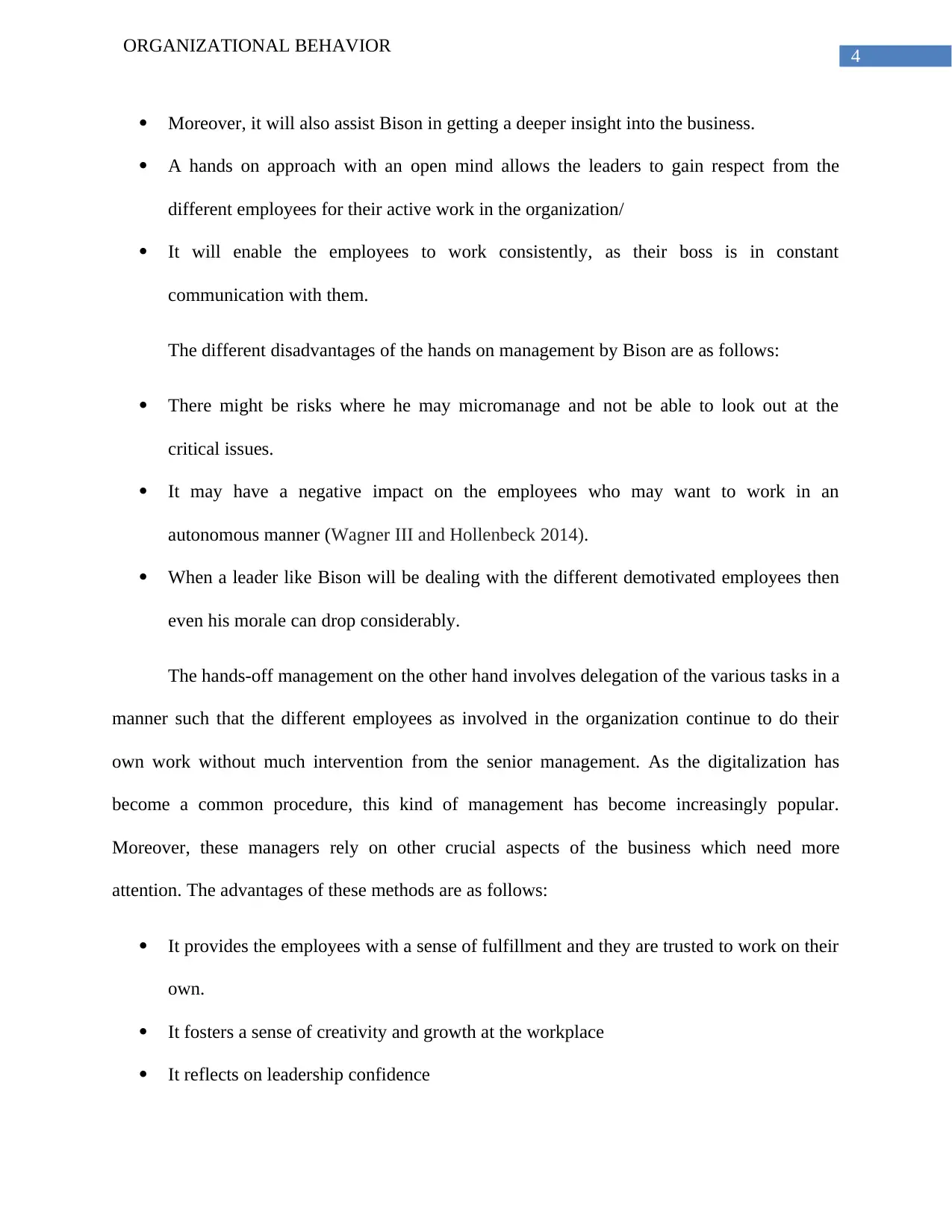
4
ORGANIZATIONAL BEHAVIOR
Moreover, it will also assist Bison in getting a deeper insight into the business.
A hands on approach with an open mind allows the leaders to gain respect from the
different employees for their active work in the organization/
It will enable the employees to work consistently, as their boss is in constant
communication with them.
The different disadvantages of the hands on management by Bison are as follows:
There might be risks where he may micromanage and not be able to look out at the
critical issues.
It may have a negative impact on the employees who may want to work in an
autonomous manner (Wagner III and Hollenbeck 2014).
When a leader like Bison will be dealing with the different demotivated employees then
even his morale can drop considerably.
The hands-off management on the other hand involves delegation of the various tasks in a
manner such that the different employees as involved in the organization continue to do their
own work without much intervention from the senior management. As the digitalization has
become a common procedure, this kind of management has become increasingly popular.
Moreover, these managers rely on other crucial aspects of the business which need more
attention. The advantages of these methods are as follows:
It provides the employees with a sense of fulfillment and they are trusted to work on their
own.
It fosters a sense of creativity and growth at the workplace
It reflects on leadership confidence
ORGANIZATIONAL BEHAVIOR
Moreover, it will also assist Bison in getting a deeper insight into the business.
A hands on approach with an open mind allows the leaders to gain respect from the
different employees for their active work in the organization/
It will enable the employees to work consistently, as their boss is in constant
communication with them.
The different disadvantages of the hands on management by Bison are as follows:
There might be risks where he may micromanage and not be able to look out at the
critical issues.
It may have a negative impact on the employees who may want to work in an
autonomous manner (Wagner III and Hollenbeck 2014).
When a leader like Bison will be dealing with the different demotivated employees then
even his morale can drop considerably.
The hands-off management on the other hand involves delegation of the various tasks in a
manner such that the different employees as involved in the organization continue to do their
own work without much intervention from the senior management. As the digitalization has
become a common procedure, this kind of management has become increasingly popular.
Moreover, these managers rely on other crucial aspects of the business which need more
attention. The advantages of these methods are as follows:
It provides the employees with a sense of fulfillment and they are trusted to work on their
own.
It fosters a sense of creativity and growth at the workplace
It reflects on leadership confidence
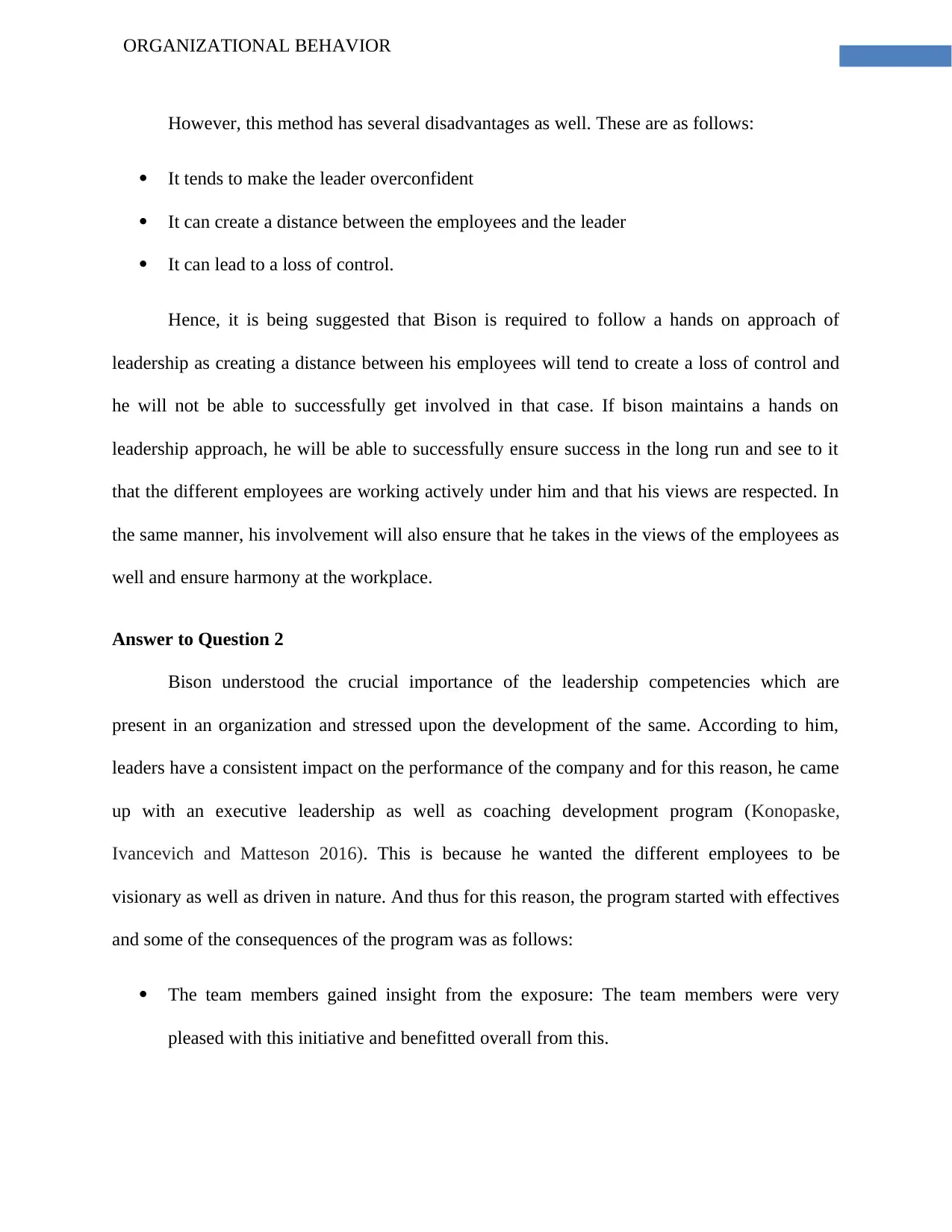
5
ORGANIZATIONAL BEHAVIOR
However, this method has several disadvantages as well. These are as follows:
It tends to make the leader overconfident
It can create a distance between the employees and the leader
It can lead to a loss of control.
Hence, it is being suggested that Bison is required to follow a hands on approach of
leadership as creating a distance between his employees will tend to create a loss of control and
he will not be able to successfully get involved in that case. If bison maintains a hands on
leadership approach, he will be able to successfully ensure success in the long run and see to it
that the different employees are working actively under him and that his views are respected. In
the same manner, his involvement will also ensure that he takes in the views of the employees as
well and ensure harmony at the workplace.
Answer to Question 2
Bison understood the crucial importance of the leadership competencies which are
present in an organization and stressed upon the development of the same. According to him,
leaders have a consistent impact on the performance of the company and for this reason, he came
up with an executive leadership as well as coaching development program (Konopaske,
Ivancevich and Matteson 2016). This is because he wanted the different employees to be
visionary as well as driven in nature. And thus for this reason, the program started with effectives
and some of the consequences of the program was as follows:
The team members gained insight from the exposure: The team members were very
pleased with this initiative and benefitted overall from this.
ORGANIZATIONAL BEHAVIOR
However, this method has several disadvantages as well. These are as follows:
It tends to make the leader overconfident
It can create a distance between the employees and the leader
It can lead to a loss of control.
Hence, it is being suggested that Bison is required to follow a hands on approach of
leadership as creating a distance between his employees will tend to create a loss of control and
he will not be able to successfully get involved in that case. If bison maintains a hands on
leadership approach, he will be able to successfully ensure success in the long run and see to it
that the different employees are working actively under him and that his views are respected. In
the same manner, his involvement will also ensure that he takes in the views of the employees as
well and ensure harmony at the workplace.
Answer to Question 2
Bison understood the crucial importance of the leadership competencies which are
present in an organization and stressed upon the development of the same. According to him,
leaders have a consistent impact on the performance of the company and for this reason, he came
up with an executive leadership as well as coaching development program (Konopaske,
Ivancevich and Matteson 2016). This is because he wanted the different employees to be
visionary as well as driven in nature. And thus for this reason, the program started with effectives
and some of the consequences of the program was as follows:
The team members gained insight from the exposure: The team members were very
pleased with this initiative and benefitted overall from this.
⊘ This is a preview!⊘
Do you want full access?
Subscribe today to unlock all pages.

Trusted by 1+ million students worldwide
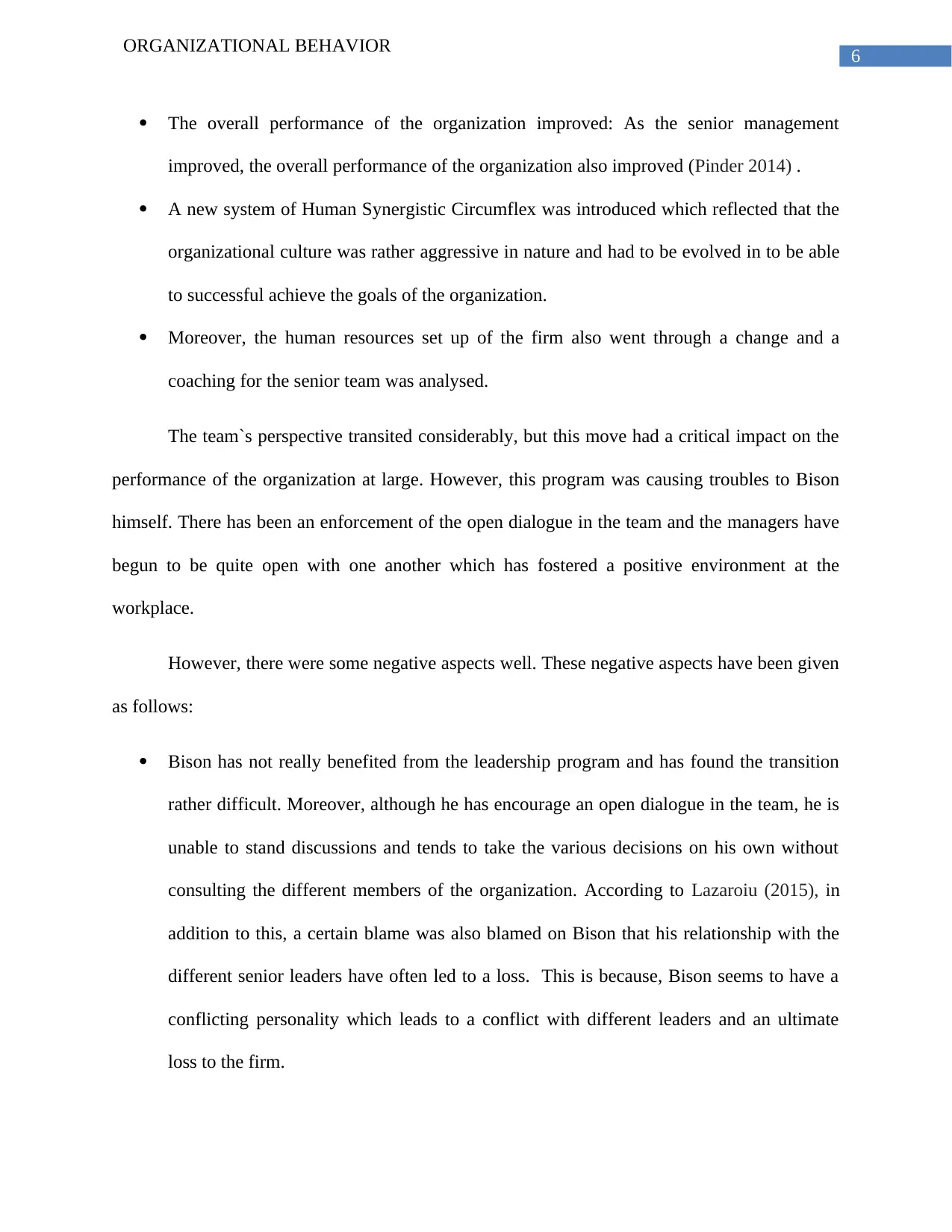
6
ORGANIZATIONAL BEHAVIOR
The overall performance of the organization improved: As the senior management
improved, the overall performance of the organization also improved (Pinder 2014) .
A new system of Human Synergistic Circumflex was introduced which reflected that the
organizational culture was rather aggressive in nature and had to be evolved in to be able
to successful achieve the goals of the organization.
Moreover, the human resources set up of the firm also went through a change and a
coaching for the senior team was analysed.
The team`s perspective transited considerably, but this move had a critical impact on the
performance of the organization at large. However, this program was causing troubles to Bison
himself. There has been an enforcement of the open dialogue in the team and the managers have
begun to be quite open with one another which has fostered a positive environment at the
workplace.
However, there were some negative aspects well. These negative aspects have been given
as follows:
Bison has not really benefited from the leadership program and has found the transition
rather difficult. Moreover, although he has encourage an open dialogue in the team, he is
unable to stand discussions and tends to take the various decisions on his own without
consulting the different members of the organization. According to Lazaroiu (2015), in
addition to this, a certain blame was also blamed on Bison that his relationship with the
different senior leaders have often led to a loss. This is because, Bison seems to have a
conflicting personality which leads to a conflict with different leaders and an ultimate
loss to the firm.
ORGANIZATIONAL BEHAVIOR
The overall performance of the organization improved: As the senior management
improved, the overall performance of the organization also improved (Pinder 2014) .
A new system of Human Synergistic Circumflex was introduced which reflected that the
organizational culture was rather aggressive in nature and had to be evolved in to be able
to successful achieve the goals of the organization.
Moreover, the human resources set up of the firm also went through a change and a
coaching for the senior team was analysed.
The team`s perspective transited considerably, but this move had a critical impact on the
performance of the organization at large. However, this program was causing troubles to Bison
himself. There has been an enforcement of the open dialogue in the team and the managers have
begun to be quite open with one another which has fostered a positive environment at the
workplace.
However, there were some negative aspects well. These negative aspects have been given
as follows:
Bison has not really benefited from the leadership program and has found the transition
rather difficult. Moreover, although he has encourage an open dialogue in the team, he is
unable to stand discussions and tends to take the various decisions on his own without
consulting the different members of the organization. According to Lazaroiu (2015), in
addition to this, a certain blame was also blamed on Bison that his relationship with the
different senior leaders have often led to a loss. This is because, Bison seems to have a
conflicting personality which leads to a conflict with different leaders and an ultimate
loss to the firm.
Paraphrase This Document
Need a fresh take? Get an instant paraphrase of this document with our AI Paraphraser
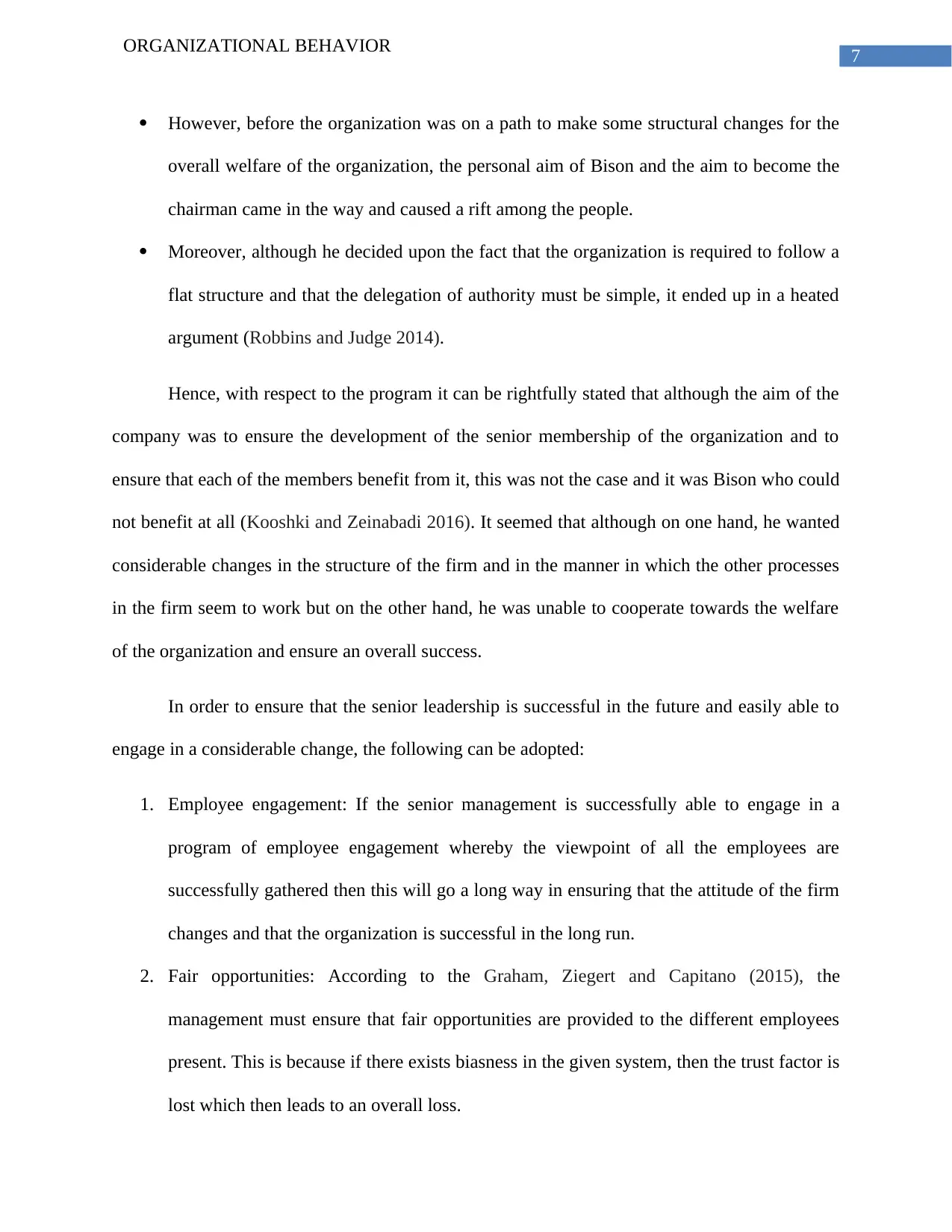
7
ORGANIZATIONAL BEHAVIOR
However, before the organization was on a path to make some structural changes for the
overall welfare of the organization, the personal aim of Bison and the aim to become the
chairman came in the way and caused a rift among the people.
Moreover, although he decided upon the fact that the organization is required to follow a
flat structure and that the delegation of authority must be simple, it ended up in a heated
argument (Robbins and Judge 2014).
Hence, with respect to the program it can be rightfully stated that although the aim of the
company was to ensure the development of the senior membership of the organization and to
ensure that each of the members benefit from it, this was not the case and it was Bison who could
not benefit at all (Kooshki and Zeinabadi 2016). It seemed that although on one hand, he wanted
considerable changes in the structure of the firm and in the manner in which the other processes
in the firm seem to work but on the other hand, he was unable to cooperate towards the welfare
of the organization and ensure an overall success.
In order to ensure that the senior leadership is successful in the future and easily able to
engage in a considerable change, the following can be adopted:
1. Employee engagement: If the senior management is successfully able to engage in a
program of employee engagement whereby the viewpoint of all the employees are
successfully gathered then this will go a long way in ensuring that the attitude of the firm
changes and that the organization is successful in the long run.
2. Fair opportunities: According to the Graham, Ziegert and Capitano (2015), the
management must ensure that fair opportunities are provided to the different employees
present. This is because if there exists biasness in the given system, then the trust factor is
lost which then leads to an overall loss.
ORGANIZATIONAL BEHAVIOR
However, before the organization was on a path to make some structural changes for the
overall welfare of the organization, the personal aim of Bison and the aim to become the
chairman came in the way and caused a rift among the people.
Moreover, although he decided upon the fact that the organization is required to follow a
flat structure and that the delegation of authority must be simple, it ended up in a heated
argument (Robbins and Judge 2014).
Hence, with respect to the program it can be rightfully stated that although the aim of the
company was to ensure the development of the senior membership of the organization and to
ensure that each of the members benefit from it, this was not the case and it was Bison who could
not benefit at all (Kooshki and Zeinabadi 2016). It seemed that although on one hand, he wanted
considerable changes in the structure of the firm and in the manner in which the other processes
in the firm seem to work but on the other hand, he was unable to cooperate towards the welfare
of the organization and ensure an overall success.
In order to ensure that the senior leadership is successful in the future and easily able to
engage in a considerable change, the following can be adopted:
1. Employee engagement: If the senior management is successfully able to engage in a
program of employee engagement whereby the viewpoint of all the employees are
successfully gathered then this will go a long way in ensuring that the attitude of the firm
changes and that the organization is successful in the long run.
2. Fair opportunities: According to the Graham, Ziegert and Capitano (2015), the
management must ensure that fair opportunities are provided to the different employees
present. This is because if there exists biasness in the given system, then the trust factor is
lost which then leads to an overall loss.
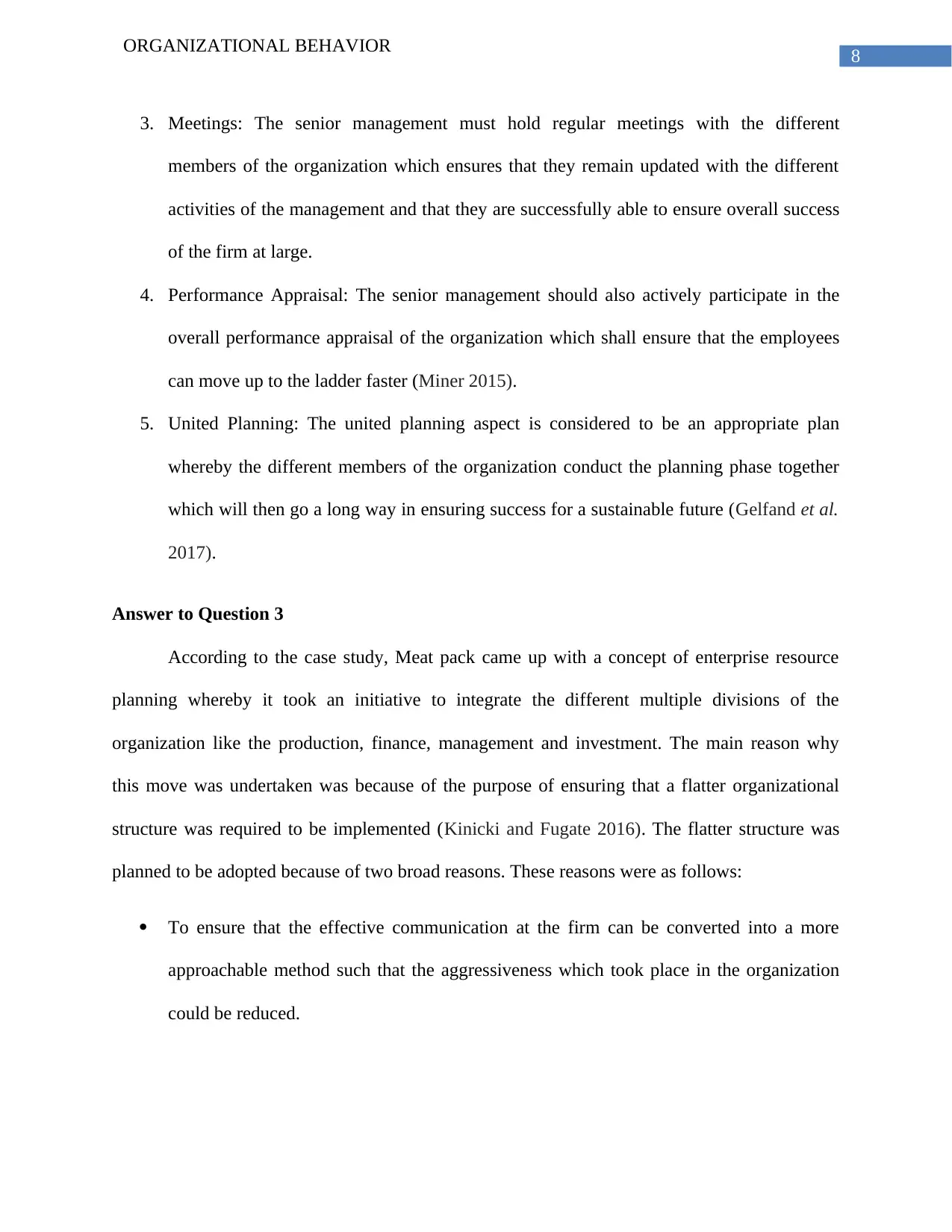
8
ORGANIZATIONAL BEHAVIOR
3. Meetings: The senior management must hold regular meetings with the different
members of the organization which ensures that they remain updated with the different
activities of the management and that they are successfully able to ensure overall success
of the firm at large.
4. Performance Appraisal: The senior management should also actively participate in the
overall performance appraisal of the organization which shall ensure that the employees
can move up to the ladder faster (Miner 2015).
5. United Planning: The united planning aspect is considered to be an appropriate plan
whereby the different members of the organization conduct the planning phase together
which will then go a long way in ensuring success for a sustainable future (Gelfand et al.
2017).
Answer to Question 3
According to the case study, Meat pack came up with a concept of enterprise resource
planning whereby it took an initiative to integrate the different multiple divisions of the
organization like the production, finance, management and investment. The main reason why
this move was undertaken was because of the purpose of ensuring that a flatter organizational
structure was required to be implemented (Kinicki and Fugate 2016). The flatter structure was
planned to be adopted because of two broad reasons. These reasons were as follows:
To ensure that the effective communication at the firm can be converted into a more
approachable method such that the aggressiveness which took place in the organization
could be reduced.
ORGANIZATIONAL BEHAVIOR
3. Meetings: The senior management must hold regular meetings with the different
members of the organization which ensures that they remain updated with the different
activities of the management and that they are successfully able to ensure overall success
of the firm at large.
4. Performance Appraisal: The senior management should also actively participate in the
overall performance appraisal of the organization which shall ensure that the employees
can move up to the ladder faster (Miner 2015).
5. United Planning: The united planning aspect is considered to be an appropriate plan
whereby the different members of the organization conduct the planning phase together
which will then go a long way in ensuring success for a sustainable future (Gelfand et al.
2017).
Answer to Question 3
According to the case study, Meat pack came up with a concept of enterprise resource
planning whereby it took an initiative to integrate the different multiple divisions of the
organization like the production, finance, management and investment. The main reason why
this move was undertaken was because of the purpose of ensuring that a flatter organizational
structure was required to be implemented (Kinicki and Fugate 2016). The flatter structure was
planned to be adopted because of two broad reasons. These reasons were as follows:
To ensure that the effective communication at the firm can be converted into a more
approachable method such that the aggressiveness which took place in the organization
could be reduced.
⊘ This is a preview!⊘
Do you want full access?
Subscribe today to unlock all pages.

Trusted by 1+ million students worldwide
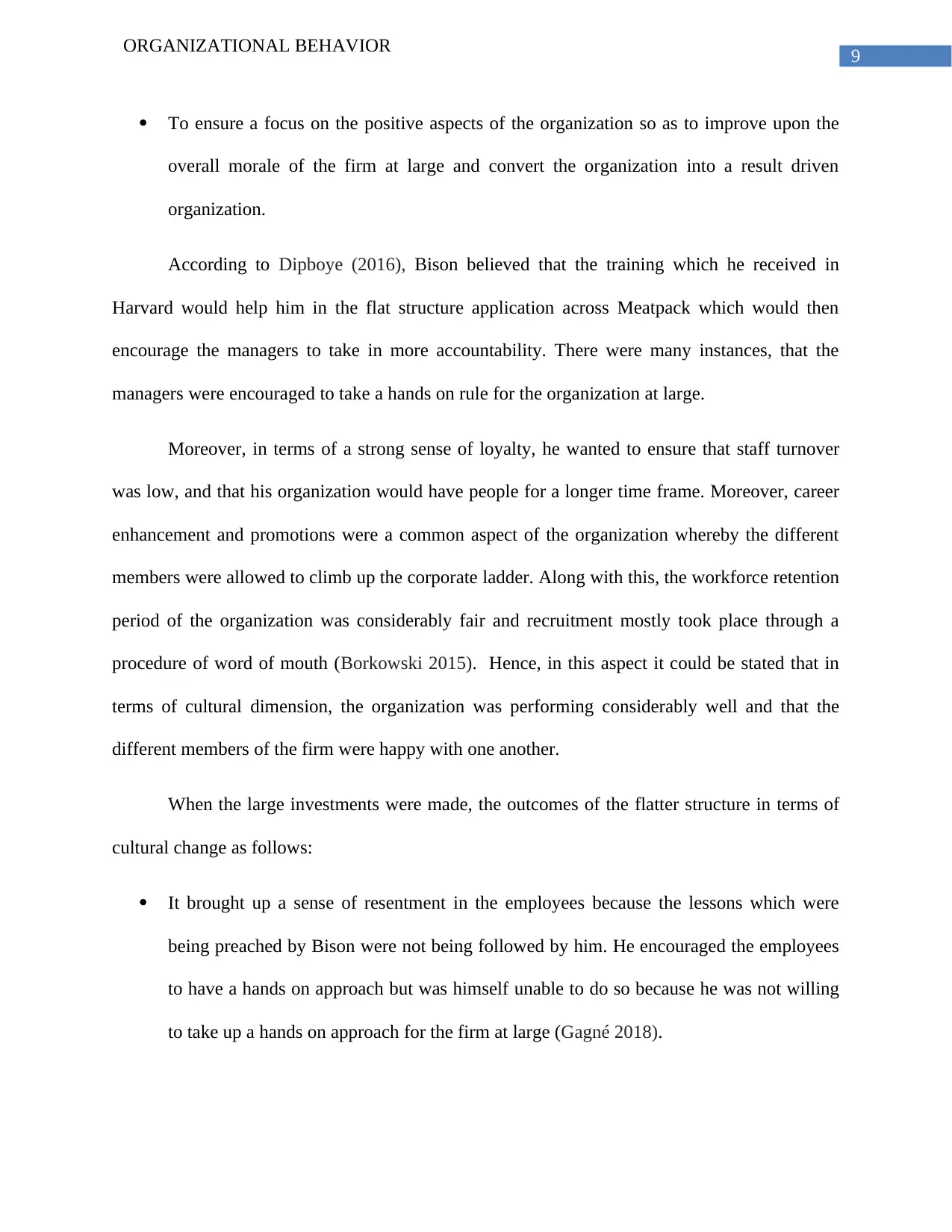
9
ORGANIZATIONAL BEHAVIOR
To ensure a focus on the positive aspects of the organization so as to improve upon the
overall morale of the firm at large and convert the organization into a result driven
organization.
According to Dipboye (2016), Bison believed that the training which he received in
Harvard would help him in the flat structure application across Meatpack which would then
encourage the managers to take in more accountability. There were many instances, that the
managers were encouraged to take a hands on rule for the organization at large.
Moreover, in terms of a strong sense of loyalty, he wanted to ensure that staff turnover
was low, and that his organization would have people for a longer time frame. Moreover, career
enhancement and promotions were a common aspect of the organization whereby the different
members were allowed to climb up the corporate ladder. Along with this, the workforce retention
period of the organization was considerably fair and recruitment mostly took place through a
procedure of word of mouth (Borkowski 2015). Hence, in this aspect it could be stated that in
terms of cultural dimension, the organization was performing considerably well and that the
different members of the firm were happy with one another.
When the large investments were made, the outcomes of the flatter structure in terms of
cultural change as follows:
It brought up a sense of resentment in the employees because the lessons which were
being preached by Bison were not being followed by him. He encouraged the employees
to have a hands on approach but was himself unable to do so because he was not willing
to take up a hands on approach for the firm at large (Gagné 2018).
ORGANIZATIONAL BEHAVIOR
To ensure a focus on the positive aspects of the organization so as to improve upon the
overall morale of the firm at large and convert the organization into a result driven
organization.
According to Dipboye (2016), Bison believed that the training which he received in
Harvard would help him in the flat structure application across Meatpack which would then
encourage the managers to take in more accountability. There were many instances, that the
managers were encouraged to take a hands on rule for the organization at large.
Moreover, in terms of a strong sense of loyalty, he wanted to ensure that staff turnover
was low, and that his organization would have people for a longer time frame. Moreover, career
enhancement and promotions were a common aspect of the organization whereby the different
members were allowed to climb up the corporate ladder. Along with this, the workforce retention
period of the organization was considerably fair and recruitment mostly took place through a
procedure of word of mouth (Borkowski 2015). Hence, in this aspect it could be stated that in
terms of cultural dimension, the organization was performing considerably well and that the
different members of the firm were happy with one another.
When the large investments were made, the outcomes of the flatter structure in terms of
cultural change as follows:
It brought up a sense of resentment in the employees because the lessons which were
being preached by Bison were not being followed by him. He encouraged the employees
to have a hands on approach but was himself unable to do so because he was not willing
to take up a hands on approach for the firm at large (Gagné 2018).
Paraphrase This Document
Need a fresh take? Get an instant paraphrase of this document with our AI Paraphraser
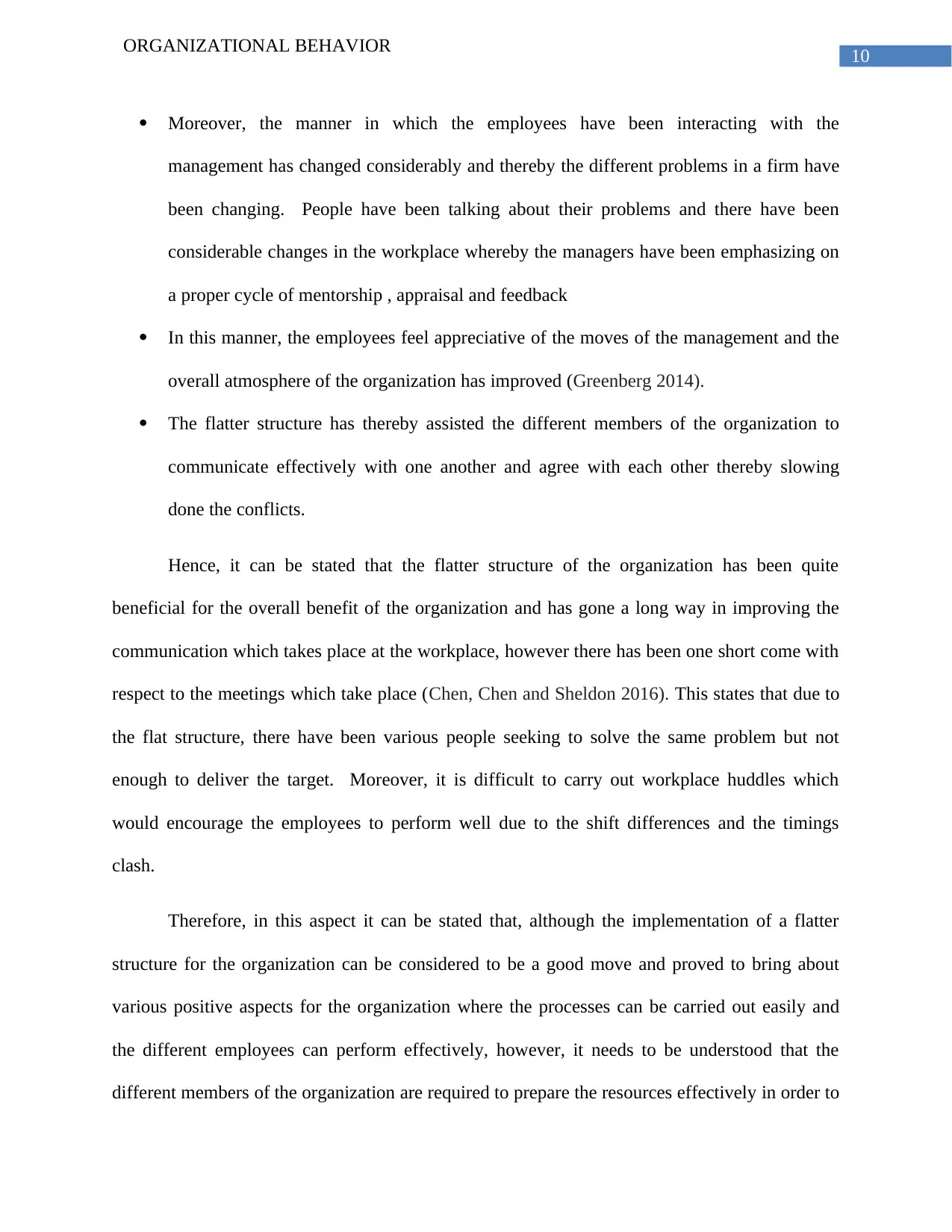
10
ORGANIZATIONAL BEHAVIOR
Moreover, the manner in which the employees have been interacting with the
management has changed considerably and thereby the different problems in a firm have
been changing. People have been talking about their problems and there have been
considerable changes in the workplace whereby the managers have been emphasizing on
a proper cycle of mentorship , appraisal and feedback
In this manner, the employees feel appreciative of the moves of the management and the
overall atmosphere of the organization has improved (Greenberg 2014).
The flatter structure has thereby assisted the different members of the organization to
communicate effectively with one another and agree with each other thereby slowing
done the conflicts.
Hence, it can be stated that the flatter structure of the organization has been quite
beneficial for the overall benefit of the organization and has gone a long way in improving the
communication which takes place at the workplace, however there has been one short come with
respect to the meetings which take place (Chen, Chen and Sheldon 2016). This states that due to
the flat structure, there have been various people seeking to solve the same problem but not
enough to deliver the target. Moreover, it is difficult to carry out workplace huddles which
would encourage the employees to perform well due to the shift differences and the timings
clash.
Therefore, in this aspect it can be stated that, although the implementation of a flatter
structure for the organization can be considered to be a good move and proved to bring about
various positive aspects for the organization where the processes can be carried out easily and
the different employees can perform effectively, however, it needs to be understood that the
different members of the organization are required to prepare the resources effectively in order to
ORGANIZATIONAL BEHAVIOR
Moreover, the manner in which the employees have been interacting with the
management has changed considerably and thereby the different problems in a firm have
been changing. People have been talking about their problems and there have been
considerable changes in the workplace whereby the managers have been emphasizing on
a proper cycle of mentorship , appraisal and feedback
In this manner, the employees feel appreciative of the moves of the management and the
overall atmosphere of the organization has improved (Greenberg 2014).
The flatter structure has thereby assisted the different members of the organization to
communicate effectively with one another and agree with each other thereby slowing
done the conflicts.
Hence, it can be stated that the flatter structure of the organization has been quite
beneficial for the overall benefit of the organization and has gone a long way in improving the
communication which takes place at the workplace, however there has been one short come with
respect to the meetings which take place (Chen, Chen and Sheldon 2016). This states that due to
the flat structure, there have been various people seeking to solve the same problem but not
enough to deliver the target. Moreover, it is difficult to carry out workplace huddles which
would encourage the employees to perform well due to the shift differences and the timings
clash.
Therefore, in this aspect it can be stated that, although the implementation of a flatter
structure for the organization can be considered to be a good move and proved to bring about
various positive aspects for the organization where the processes can be carried out easily and
the different employees can perform effectively, however, it needs to be understood that the
different members of the organization are required to prepare the resources effectively in order to
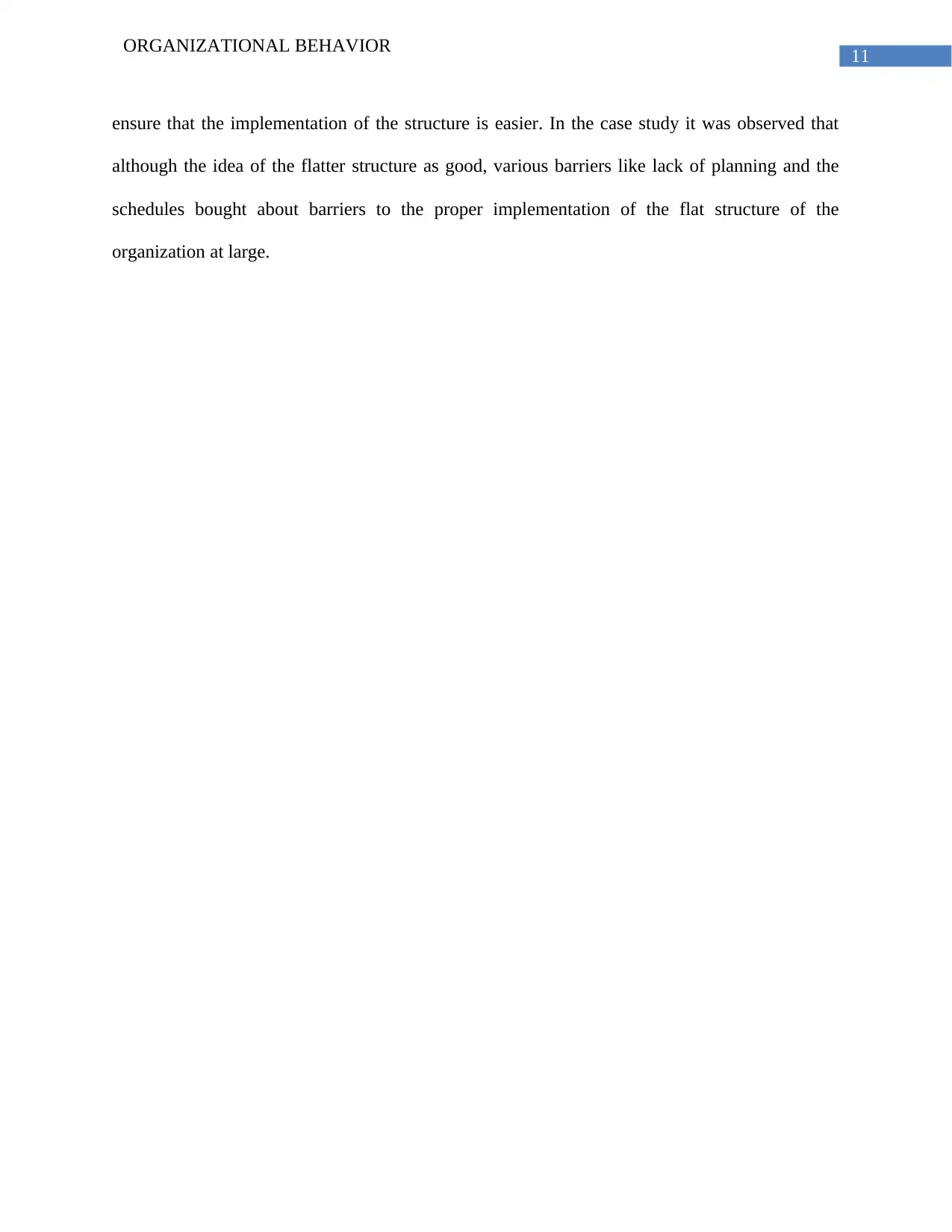
11
ORGANIZATIONAL BEHAVIOR
ensure that the implementation of the structure is easier. In the case study it was observed that
although the idea of the flatter structure as good, various barriers like lack of planning and the
schedules bought about barriers to the proper implementation of the flat structure of the
organization at large.
ORGANIZATIONAL BEHAVIOR
ensure that the implementation of the structure is easier. In the case study it was observed that
although the idea of the flatter structure as good, various barriers like lack of planning and the
schedules bought about barriers to the proper implementation of the flat structure of the
organization at large.
⊘ This is a preview!⊘
Do you want full access?
Subscribe today to unlock all pages.

Trusted by 1+ million students worldwide
1 out of 15
Related Documents
Your All-in-One AI-Powered Toolkit for Academic Success.
+13062052269
info@desklib.com
Available 24*7 on WhatsApp / Email
![[object Object]](/_next/static/media/star-bottom.7253800d.svg)
Unlock your academic potential
Copyright © 2020–2025 A2Z Services. All Rights Reserved. Developed and managed by ZUCOL.




